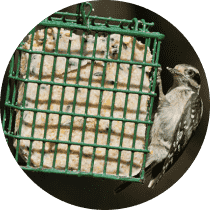Ladder-backed Woodpecker
A species of Three-toed woodpeckers Scientific name : Dryobates scalaris Genus : Three-toed woodpeckers
Ladder-backed Woodpecker, A species of Three-toed woodpeckers
Botanical name: Dryobates scalaris
Genus: Three-toed woodpeckers
Content
Description People often ask General Info

Description
The ladder-backed woodpecker is a small woodpecker about 16.5 to 19 cm (6½ to 7½ inches) in length. It is primarily colored black and white, with a barred pattern on its back and wings resembling the rungs of a ladder. Its rump is speckled with black, as are its cream-colored underparts on the breast and flanks. Southern populations have duskier buff breasts and distinctly smaller bills. Adult males have a red crown patch that is smaller in immatures and lacking in adult females. The ladder-backed woodpecker is very similar in appearance to Nuttall's woodpecker, but has much less black on its head and upper back, and the range of the two species only intersects a minimal amount in southern California and northern Baja California. Hybrids are known. Ladder-backed woodpeckers nest in cavities excavated from tree trunks, or in more arid environments a large cactus will do. The female lays between 2 and 7 eggs, which are plain white. The eggs are incubated by both sexes, but the nesting period and other details are unknown. Like most other woodpeckers the ladder-backed woodpecker bores into tree-trunks with its chisel-like bill to hunt for insects and their larva, but it also feeds on fruit produced by cacti. 
Size
13 - 23 cm
Colors
Black
Red
White
Orange
Life Expectancy
4 years
Nest Placement
Cavity
Clutch Size
2 - 7 eggs
Incubation Period
1 brood
Feeding Habits
Ladder-backed Woodpecker's diet mainly consists of insect larvae, adult insects including beetles, leafworms, ants, caterpillars, hemipterans, and occasionally cactus fruit. Ladder-backed Woodpecker forages by various methods, seldom digs deeply for prey, and males and females differ in foraging locations. Ladder-backed Woodpecker does not cache food or catch insects in midair.
Habitat
Ladder-backed Woodpecker typically inhabit arid to semi-arid regions, including dry brushy areas, thickets, thorn forests, deserts, and desert scrublands. They are found from low elevations to higher altitudes of about 7,600 feet in the U.S. and up to 8,000 feet in Mexico. The bird favors environments with vegetation such as agave, Joshua tree, mesquite, paloverde, catclaw, yucca, acacia, and various cacti. While less frequent in riparian zones where they coexist with Nuttall's Woodpecker, ladder-backed Woodpecker thrive in xeric habitats and extend into juniper-pinyon woodlands and pine-oak forests within its range.
Nest Behavior
Ladder-backed Woodpecker's nesting period involves the male primarily excavating the cavity from late winter through spring.
Nest Characteristics
Ladder-backed Woodpecker typically excavates nests in trees like Joshua tree, willow, and oak, or in yucca, agave, and old fence posts, with cavity entrances 1.25 to 1.6 inches wide, depth of 7–14 inches, and a 3.25-inch base diameter, often placed 2 to 30 feet high without adding nesting materials.
Dite type
Insectivorous
People often ask
General Info
Feeding Habits
Bird food type
Bird Feeder Type

Suet Cage
Sounds
Call
Recording location: Mexico
Call
Recording location: United States
Drum
Recording location: United States
Behavior
Ladder-backed Woodpecker exhibit remarkable agility with their stiff tails and nimble feet, allowing them to maneuver and feed on a variety of plant surfaces. Their daily activities include hopping and contorting around trunks and branches, ascending in search of food. They typically rekindle or establish breeding pairs in winter or early spring. Unique behaviors are observed during rival interactions and territory disputes with similar species, such as bill-pointing, head-bobbing, and displaying 'moth flight,' where they showcase an unusual flight pattern, wings spread or pointed downward momentarily.


Scientific Classification
Phylum
Chordates Class
Birds Family
Woodpeckers Genus
Three-toed woodpeckers Species
Ladder-backed Woodpecker